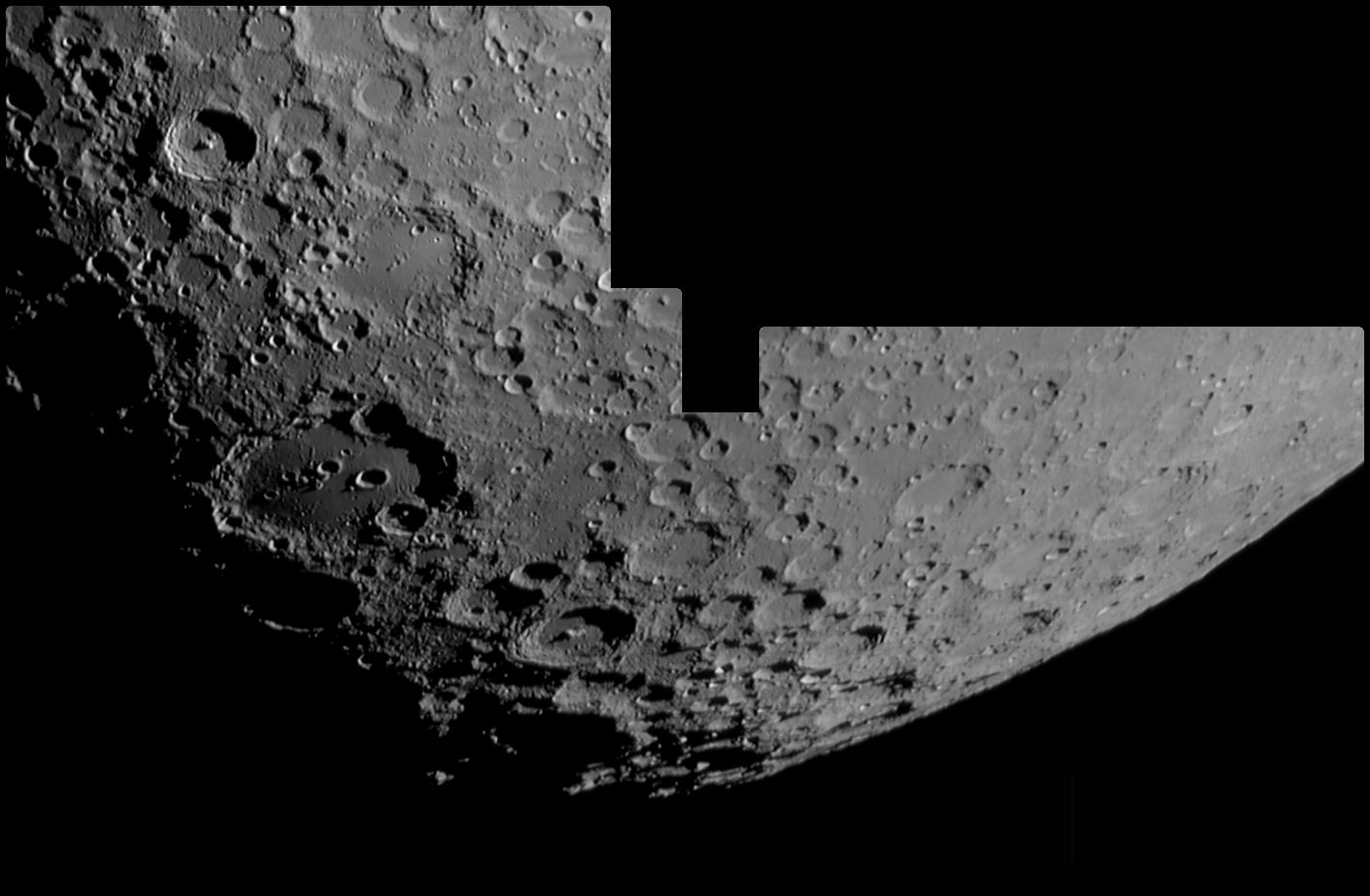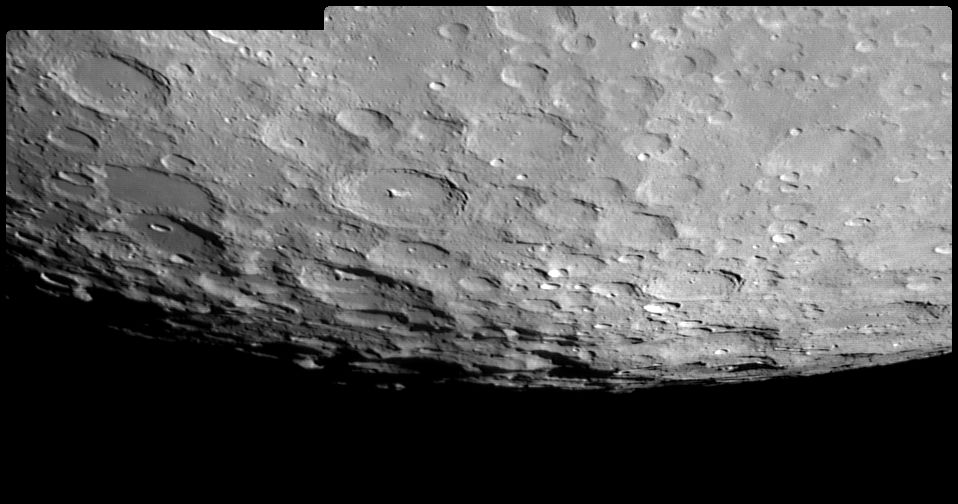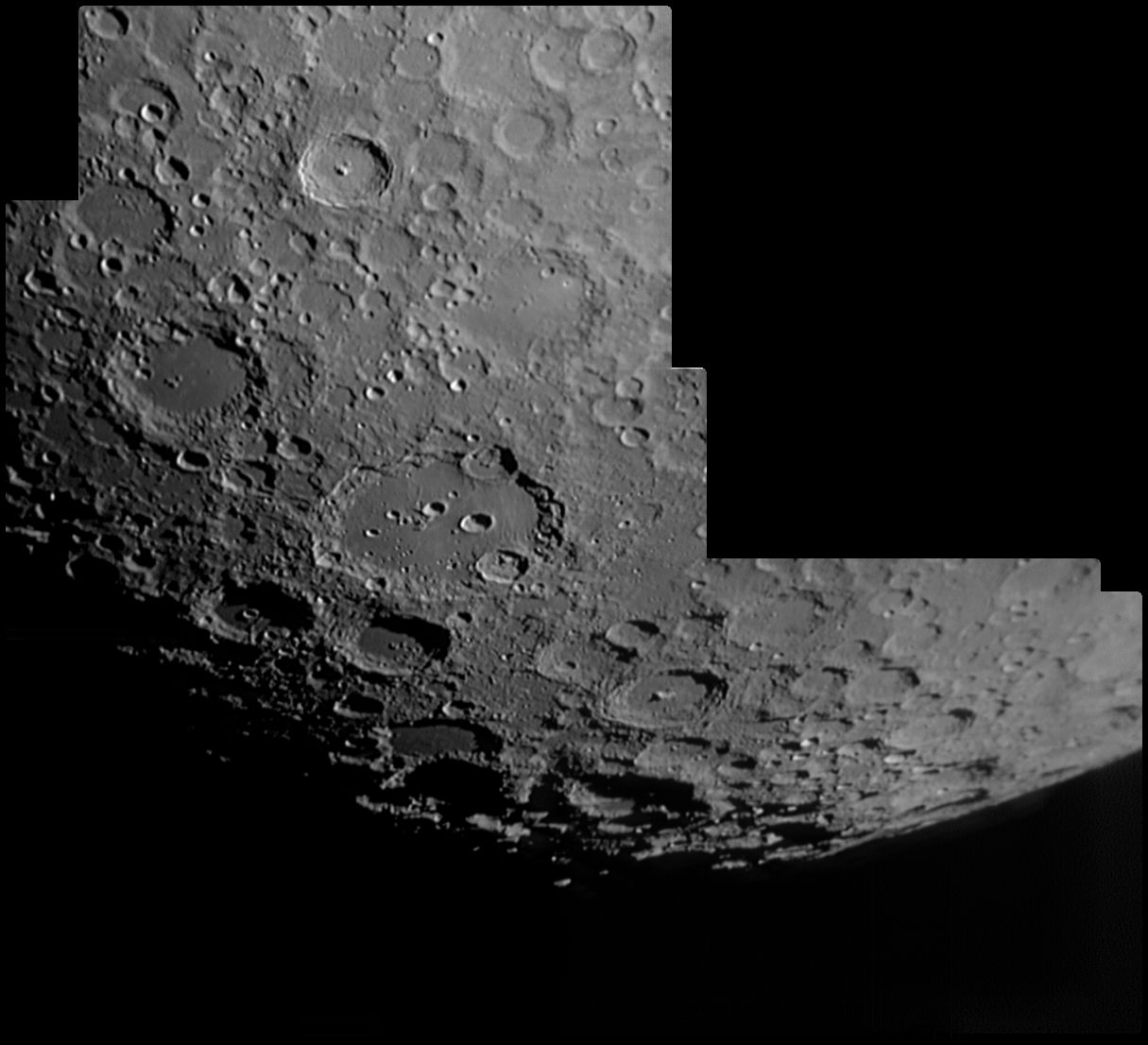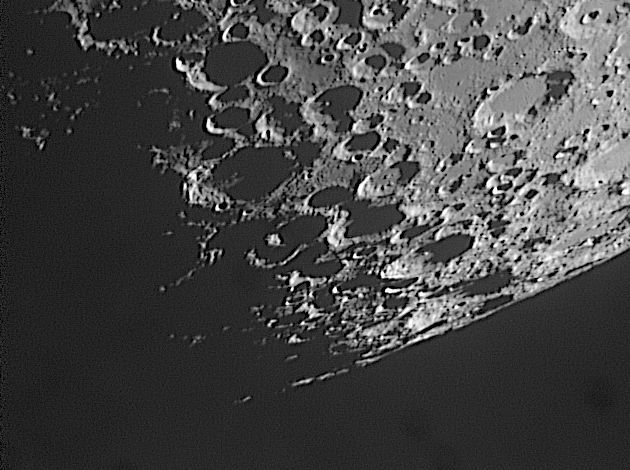The South Pole 
Move your mouse over the picture to see the names of the various features.

|
This picture was taken when the libration was about as favourable as it ever gets at
-6° 24' in latitude and 1° 9' in longitude. The solar inclination was also
favourable at -0.6° so at least the pole was illuminated (if only just). The
phase could perhaps have been better but we seldom get everything in this world.
Labelling this picture was a nightmare. Not only are there so many craters in this
area, they all seem to have names. Near the top of the picture is Tycho, one of the youngest
craters on the Moon being only 109 million years old. It is 85 Km in diameter,
4800 metres deep, with a central mountain 2250 metres high with three main peaks.
It is best known for its extensive system of rays which are so clearly seen at
full moon, but which don't show in a picture like this. In
contrast, Marginus is an ancient crater dating back more than 4,000 million years and is
168 Km in diameter. Further south is Clavius, possibly my favourite, and the subject of a
much closer picture elsewhere. Further south again is Moretus,
a comparative youngster at around 2,000 million years, 117 Km in diameter and 5000 metres deep.
It's central mountain rises 2700 metres. In the very far south we find Scott and Amundsen
named after the two explorers who first reached the Earth's south pole. They are about the same size
at 110 Km; perhaps it is appropriate that Amundsen, who reached the pole first, is the further south.
Another crater of note is Zach which is another old crater at 3,800 million years old, and is 73 Km
in diameter and 3700 metres deep.
It is impossible to show a realistic north-south scale marker in this picture because the scale
changes so much in different parts. The marker points as best I can determine at the South Pole
and points in the direction of the prime meridian (which passes 0.5° east of Short A and
1.7° west of Lilius F). The other marker is about 100 Km east.
The picture is a mosaic of 5 pictures which were taken with a ToUcam attached to my LX200 on 19th March 2005,
when the Moon was 10.4 days old.
|
|
| Date and Time |
19th March 2005 at around 19:30 UT |
Camera |
ToUcam 740K |
Telescope |
LX200 |
Capture |
K3CCDTools. High gamma, 1/100", 9% gain |
Processing |
Registax. Wavelet 1-2 = 10, 3 = 5 |
____________________________________________________________________________________________________________________________________________________
This picture was taken the day after the picture above and covers about the same area.
The libration had changed a little and was -6° 12' in latitude and 0° 35' in longitude.
The shortening of the shadows is very obvious.
Just as in the picture above, one marker points as best I can determine at the South Pole
and points in the direction of the prime meridian. The other marker is about 100 Km east.
The picture is a mosaic of 8 pictures which were taken with a ToUcam attached to my LX200 on 20th March 2005,
when the Moon was 11.3 days old. The seeing was poor and deteriorated during the session.
|
|
| Date and Time |
20th March 2005 at around 21:40 UT |
Camera |
ToUcam 740K |
Telescope |
LX200 |
Capture |
K3CCDTools. High gamma, 1/250", 38% gain, or 1/100", 21% gain |
Processing |
Registax. Wavelet 1-3 = 10 |
____________________________________________________________________________________________________________________________________________________

|
Another picture of the south-polar area. The libration here is not quite as good at -5° 56' in latitude as it was for the picture above, but the solar angle, at -1.5°, was as favourable as it gets. Identifying the craters in this libration zone is particularly difficult and I am by no means sure of all of them. I have indicated the ones I am most unsure about by means of a broken arrow. This includes my estimate of the South Pole. A mosaic of pictures from the Clemantine spacecraft can be seen here which was of some help to me in trying to identify the craters.
However, after I published this image, Mardi Clark of the The Whitepeak Lunar Observatory sent me this picture comparing my image with Whittaker's deffinitive map of the area. The image is inverted to correspond to Whitaker's map (and it looks more natural for a place so far south) and Mardi has identified, on my image, a number of the features on Whitaker's map. I appreciate this contribution.
One scale marker is approximately 50 Km west; the second one shows roughly the direction of the prime meridian. The reason that the direction of west is not at right angles to the prime meridian is that the libration was 5° in longitude which means that the prime meridian was moved to the left, compared with how a map would show it, to about the position occupied on the map by the 5° western meridian and, in this projection, this meridian does not appear at right angles to the east-west direction. The meridian is also curved, so the direction is not constant anyway.
The picture is a mosaic of 2 pictures taken with a ToUcam attached to my LX200 on 11th January 2006, when the Moon was 12.4 days old.
|
|
| Date and Time |
11th January 2006 at 21:15 UT |
Camera |
ToUcam 740K |
Telescope |
LX200 |
Capture |
K3CCDTools. High gamma, auto gain |
Processing |
Registax. Wavelet 1 = 10 |
____________________________________________________________________________________________________________________________________________________
Another picture of the south-polar area, taken on day 7.9 which represents early morning on this part of the Moon. The libration was favourable at -4° 3' in latitude and 2° 57' in longitude but the solar angle, at +1°, means that the south pole itself was in darkness but the light is just catching some of the high mountains nearby.
The picture was taken using an IR-pass filter about an hour before sunset (here on Earth!)
One scale marker points up the prime meridian but is of no particular length, the other indicates approximately 100 Km east and applies at Manzinus.
The picture was taken with a ToUcam attached to my LX200 on 5th May 2006, when the Moon was 7.9 days old.
|
|
| Date and Time |
5th May 2006 at 18:30 UT |
Camera |
ToUcam 740K |
Telescope |
LX200 with IR-pass filter |
Capture |
K3CCDTools. Low gamma, 1/33", 20% gain, 348 frames |
Processing |
Registax. 120 frames stacked, wavelets 1 = 10, 2 = 5, gamma 2.0, brightness -20, histogram 0-200 |
Home Back to SE quadrant Back to SW quadrant





